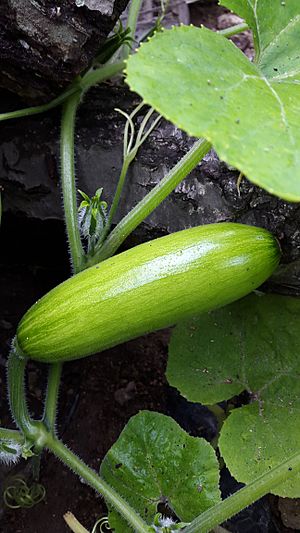Aehobak facts for kids
Quick facts for kids Aehobak |
|
|---|---|

Aehobak after rain
|
|
| Species | Cucurbita moschata |
| Cultivar |
|
| Origin | Korea |
| Korean name | |
| Hangul |
애호박
|
|---|---|
| Revised Romanization | aehobak |
| McCune–Reischauer | aehobak |
| IPA | [ɛ.ɦo.bak̚] |
Aehobak (Korean: 애호박), also called Korean zucchini or Korean courgette, is an edible, green to yellow-green summer squash. Although nearly all summer squashes are varieties of Cucurbita pepo, aehobak belongs to the species Cucurbita moschata. Commonly used in Korean cuisine, an aehobak has the shape of zucchini, but with thinner, smoother skin, and more delicate flesh. It is usually sold in shrink-wrapped plastic.
Cultivars of Korean zucchini include 'Seoulmadi', 'Bulam-sacheol', and 'Miso'.
Culinary use
In Korean cuisine, the squash is used either fresh or dried. Fresh aehobak can be pan-fried, either julienned in batter into buchimgae or sliced and egg-washed as jeon. It is often made into namul-banchan (seasoned vegetable side dish), usually seasoned with salted shrimps and stir-fried. Sometimes, aehobak features as the main ingredient in stew dishes such as jijimi and mureum. Dried aehobak, called hobak-goji, can be prepared by slicing the squash thinly and sun-drying the slices. It is soaked before cooking, then usually stir-fried to make a bokkeum or namul.
The squash is also used in royal court dishes such as seon, and more recently in wolgwa-chae, replacing the Oriental pickling melon.
-
Aehobak-namul (stir-fried aehobak)
-
Aehobak-gyeran-mari (rolled aehobak omelettes)
-
Aehobak-buchimgae (aehobak pancake)
-
Hobak-jeon (pan-fried aehobak)
-
Hobak-seon (stuffed aehobak)
See also
 In Spanish: Aehobak para niños
In Spanish: Aehobak para niños









